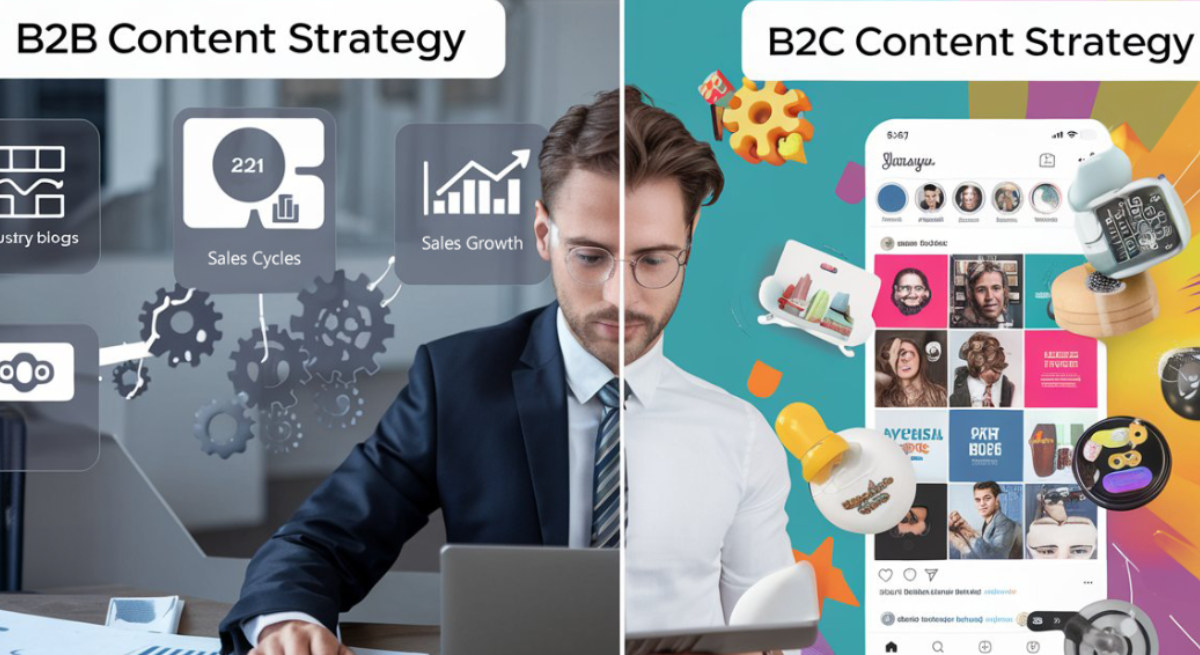

If you are a business and want to connect with people, it’s crucial to create the right type of content considering your audience. However, different types of businesses need to approach content differently based on whether the genre of business is B2C or B2B. Understanding these differences can help you craft effective content strategies that your target audience can relate to and boost your SEO rankings.
Let us first understand B2B and B2C
Before racing towards content strategies lets soak in the meaning of these 2 terms. B2B companies sell their services and products to other businesses. The transactions between them often involve longer stakes, multiple decision makers, longer sales cycles, payment periods and so on. Meanwhile, B2C businesses sell directly to the customers. The buying process is typically quicker. As simple as that!
Content Goals
B2B content Goals:
The content here aims to build relationships, establish connections and educate potential clients. The focus is on providing valuable insights that help businesses solve a specific problem. Some examples of such type of content can be Whitepapers, case studies, updates, recent or upcoming projects, industry reports, industry specific blogs etc. To sum up “content that positions your company as a trusted resource and provides some authority.”
B2C content Goals:
The aim here is to engage, entertain and persuade the audience to spend their hard-earned money on buying your products and services. Examples of content can be – engaging and attractive social media campaigns, beautifully written blog posts that keeps the audience hooked, product/ service video that highlights the benefits and why people should choose you among the plethora of others offering the same thing.
Content Types:
B2B
- Whitepapers: These are detailed resources offering valuable information and insights. They are often gated, meaning users provide contact information (such as email address) to access them, allowing for lead generation.
- Case Studies: To build trust among your audience sharing case studies is one of the best ways. By showcasing how your products or services have helped another business build credibility, it becomes easier for others to be confident in your business.
Industry Blogs: Writing informative blog posts about industry trends can attract traffic and establish expertise. The key is to put out quality content regularly about industry trends and topics. Consistency breeds trust!
B2C
- Social Media Content: Create content that is creative, engaging, visually appealing as well as quick (considering the lower attention spans). Apart from this, utilizing the stories feature, memes, and polls can keep your audience entertained and involved.
- Blog Posts: These should be engaging and relatable, focusing on lifestyle, tips, and trends that resonate with your audience. If a blog post is boring an average person wouldn’t read it past a paragraph at max. So, keep the blogs engaging by using simple words, shorter sentences, avoiding jargon and words which would force your readers to run around looking for a dictionary.
Videos / Reels: Short, engaging videos can show your products/ services, share happy customer stories, or provide behind-the-scenes looks, helping to create a personal touch with your brand. Reels are one of the best ways to reach a wider audience.
SEO Considerations
Both B2B and B2C content should be optimized for search engines, but the focus may vary.
B2B Search Engine Optimization:
Target long-tail keywords that reflect specific industry terms. For example, if you deal in large electrical control panels and are based in Mumbai, targeting a keyword like “Electrical control panel manufacturers in Mumbai” may be a great choice. Create content that answers common questions within your niche. This approach can help attract key people or decision-makers searching for solutions.
B2C Search Engine Optimization:
B2C companies might focus on broader keywords and trends, spreading their fishing net wider to reach more people. Engaging, relatable content can drive traffic and improve visibility. Additionally, using attractive visuals and optimizing for mobile can enhance user experience.
Final thoughts
While both B2B & B2C content strategies share the same goal of bonding with your targeted group of people, they differ in approach, content types and methods. By understanding these minutes but crucial differences you can craft your content strategies to meet the demands of your target market. In the grand scheme of things, the takeaway is “aligning your content with your audience’s preferences is key to success.
Author - Rishi Vishwakarma (SEO Executive)


